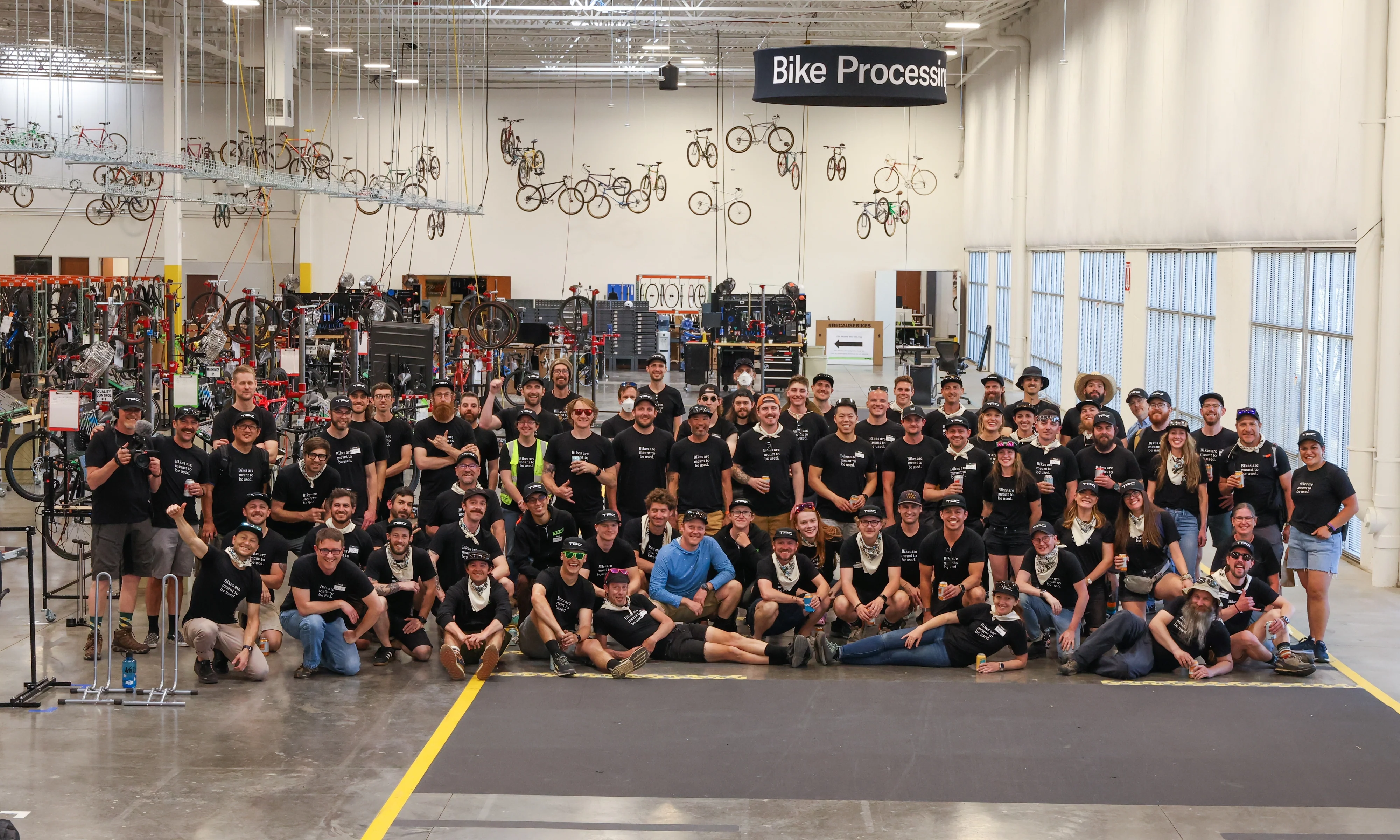Photos by Mary Metcalf and Mike Dion.
Tour Divide starts soon! If you’re a fan like me, you’ll have a tab with Trackleaders open for the next few weeks so you can follow all the intrepid bikepackers taking on the Great Divide Mountain Bike Route (GDMBR).
If you’re not familiar, the GDMBR roughly follows the Continental Divide. Going north to south, it starts in Banff, Alberta, Canada, and finishes at the US/Mexico border in Antelope Wells, New Mexico. Every year, riders will race the GDMBR for Tour Divide. While this race attracts hundreds of riders and has a major online following, it’s still a fairly underground event. There’s no television broadcast. It’s not officially sanctioned. And there’s no prize for winning. But riders still love it.
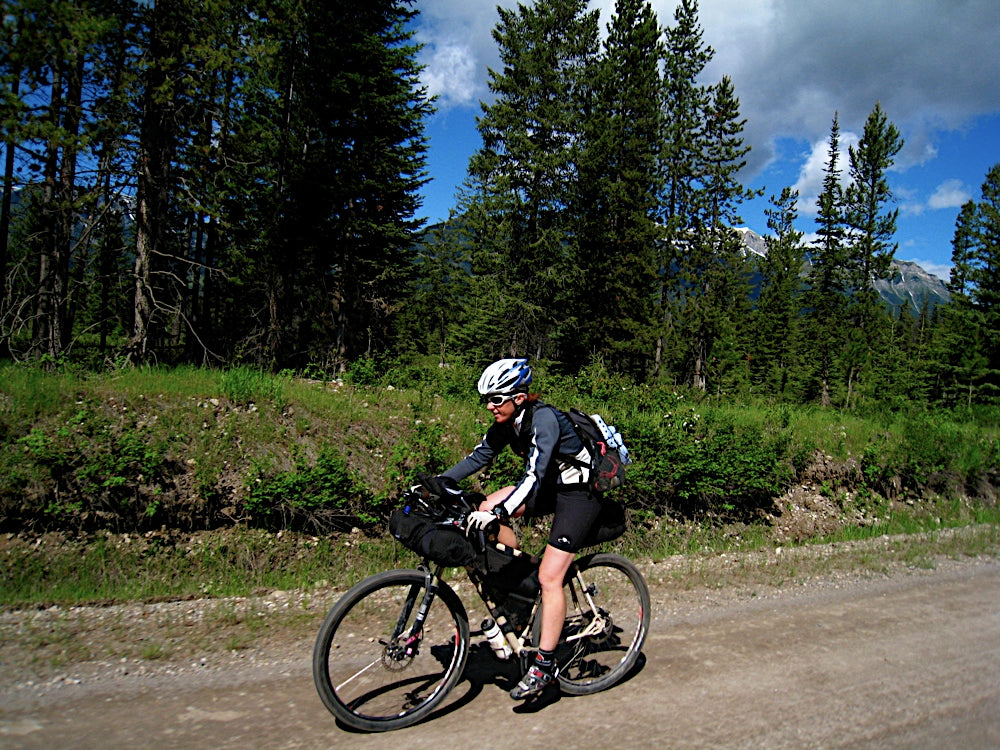 To understand why, I talked to my co-worker, Mary Metcalf, who participated in the first-ever “official” Tour Divide back in 2008. She was also the first woman to complete the race.
To understand why, I talked to my co-worker, Mary Metcalf, who participated in the first-ever “official” Tour Divide back in 2008. She was also the first woman to complete the race.
This early crew of Tour Divide racers paved the way for future participants, who are now pushing the limits of how fast they can ride and how light they can pack. Mary explains why she decided to go suffer in the mountains for days on end, and what it was like bikepacking the first-ever Tour Divide 15 years ago.
Update June 10, 2024:
Ride the Divide Returns! Mary’s epic experience at the 2008 Tour Divide was featured in the documentary Ride the Divide. Now, this cult classic is getting a commemorative re-release with Ride the Divide Returns. It's crafted from over 100 hours of unseen footage which offers a unique perspective on the original journey. Join us for the world premiere at eTown Hall in Boulder, CO, or tune in virtually on June 15th, 2024 of Ride the Divide Returns. GET TICKETS HERE.
[button]Shop Bikes[/button]
How Mary Found the First-Ever Tour Divide
 “So I started mountain bike racing in college — short, little mountain bike races. I think a lot of us have this progression. You start with a short race, and you're like, ‘Oh, could I go longer?’ I started doing some 100 milers and found that I naturally had some endurance. From there, I started doing 24-hour solo races.
“So I started mountain bike racing in college — short, little mountain bike races. I think a lot of us have this progression. You start with a short race, and you're like, ‘Oh, could I go longer?’ I started doing some 100 milers and found that I naturally had some endurance. From there, I started doing 24-hour solo races.
“To research races back in 2008, you read other people's blogs. That's how you found out about what was going on. I really got interested in the underground racing scene … and started reading some blogs about people who were riding the Great Divide Mountain Bike Route. They were mostly men. But there were a couple of women who had ridden some of the route."
 “Some people were saying on a blog that they were going to make this Great Divide Mountain Bike Route into a race. It was really just going to be a bunch of people getting together and riding it. That was around 2007. I read Matt McFee's blog, he had dropped out while riding GDMBR. He got sick from water and kind of passed out on the side of the road. I thought, ‘I think I could do that smarter. I could do that better.’ So it really piqued my interest.
“Some people were saying on a blog that they were going to make this Great Divide Mountain Bike Route into a race. It was really just going to be a bunch of people getting together and riding it. That was around 2007. I read Matt McFee's blog, he had dropped out while riding GDMBR. He got sick from water and kind of passed out on the side of the road. I thought, ‘I think I could do that smarter. I could do that better.’ So it really piqued my interest.
“I said this before, but I think it's hard to know how big it's going to be until you do it because there's no way to train or prepare for riding your bike for a month without riding your bike for a month. So it was hard to wrap my mind around how big it would be. I just knew it sounded like fun and I could get out and see a lot of the country.”
Mary’s 2008 Tour Divide Bike and Gear
A 29er Softail
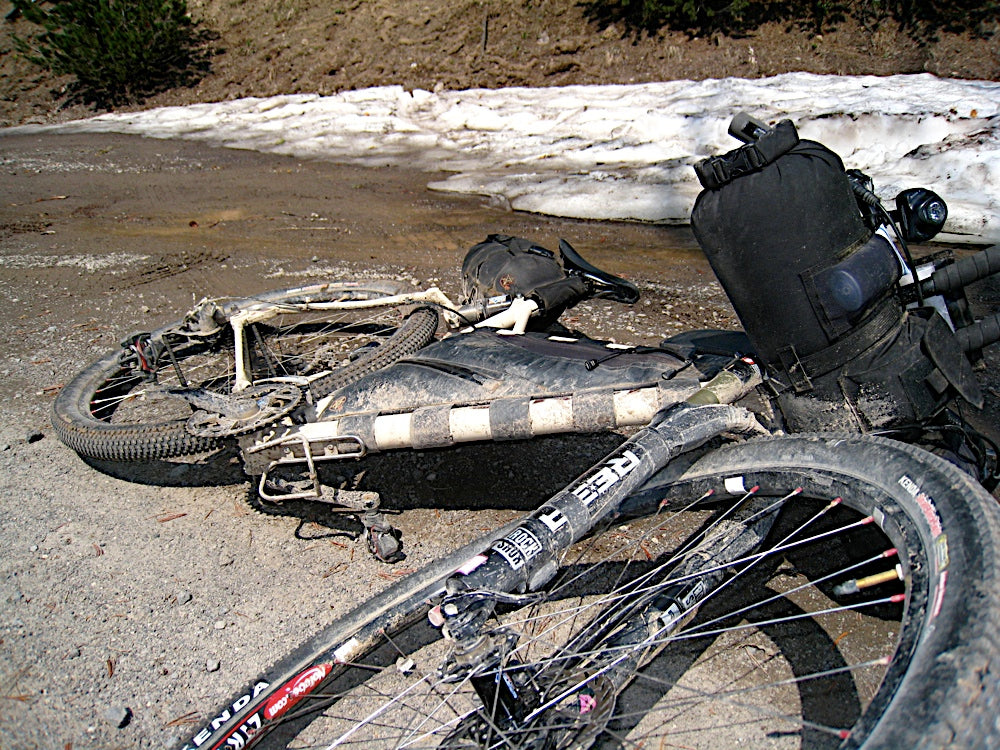 “29ers had really just started coming out. My husband at the time was fabricating 29ers. We saw that I needed something different than the 26” mountain bike that I had been riding so he actually built me a custom aluminum 29er with a softail.
“29ers had really just started coming out. My husband at the time was fabricating 29ers. We saw that I needed something different than the 26” mountain bike that I had been riding so he actually built me a custom aluminum 29er with a softail.
“Almost everyone then was riding 29er hardtails because you didn't want to carry the extra weight of a full suspension. There wasn't a lot of information but we knew that I wasn't going to need full suspension anyway. But I needed to be able to endure. I needed to be able to comfortably ride my bike 100 miles every day for a month, off-road, on washboard, on unknown trails, and in varying conditions. So we chose to build a softail. It had a titanium flex point behind the bottom bracket with a little Cane Creek shock that had an inch and a half of travel. Then we put on some fast-rolling 29er tires."
The Dawn of Bikepacking Bags
 “There were these bags made by Jeff Boatman in Alaska. Carousel Design Works was the company. He was making them one-off in his garage and he was calling them ‘bikepacking’ bags. Now we all know the term bikepacking, but it wasn't even a term back then. I didn't want to have a super-heavy bike with a full touring setup. And I also didn't want racks that might break over 3000 miles.
“There were these bags made by Jeff Boatman in Alaska. Carousel Design Works was the company. He was making them one-off in his garage and he was calling them ‘bikepacking’ bags. Now we all know the term bikepacking, but it wasn't even a term back then. I didn't want to have a super-heavy bike with a full touring setup. And I also didn't want racks that might break over 3000 miles.
“We kind of pieced together a bunch of bikepacking and backpacking gear and figured out different ways to mount it on the bike to get it off of our backs. That's kind of what everyone did then and it still holds true today.”
Handlebar Innovation
 “So we actually fabricated a widget known as the ‘Fred Bar.’ People still use it! But we ended up selling that company. It was a widget I used to fix aerobars onto a mountain bike bar because you had a different clamp diameter and handlebar position than road bars. Aerobars really just give you another position to stretch out and change up your position because you're going to be riding long days, 16-18 hours."
“So we actually fabricated a widget known as the ‘Fred Bar.’ People still use it! But we ended up selling that company. It was a widget I used to fix aerobars onto a mountain bike bar because you had a different clamp diameter and handlebar position than road bars. Aerobars really just give you another position to stretch out and change up your position because you're going to be riding long days, 16-18 hours."
Long Live the Triple
 “I rode a triple. I don't remember how big my cassette was, but it was not that big. I used all three chainrings on that triple. It was perfect.”
“I rode a triple. I don't remember how big my cassette was, but it was not that big. I used all three chainrings on that triple. It was perfect.”
*As a 1x fanatic, Mary surely said this to antagonize me.
An Early Tubeless Adopter
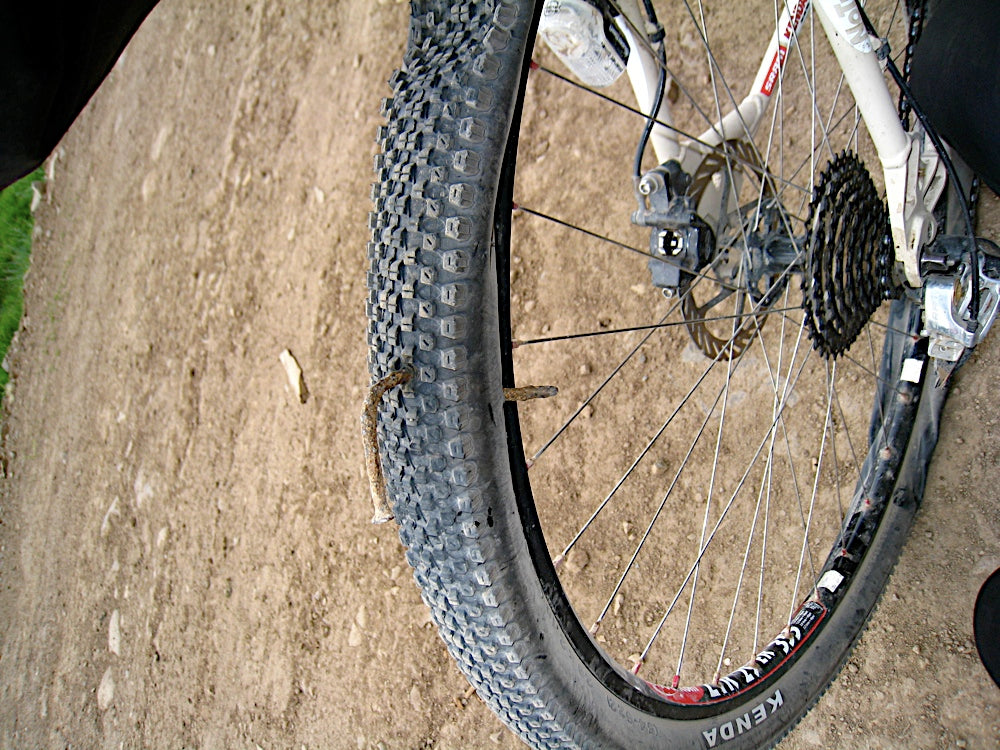 “I was sponsored by Stan’s NoTubes, so I actually rode a tubeless setup. By the time I did Tour Divide, it had gotten a bit more legit. The Stan’s rims came tubeless ready. We still had to do a lot of stuff, like tape up your rim with their specific tape, and use their sealant and everything. It wasn't that available everywhere so that was a concern. The other thing that was tough was that most tire and rim combos weren't as tight as they are now, so you really had to work really hard to get that seated and sealed."
“I was sponsored by Stan’s NoTubes, so I actually rode a tubeless setup. By the time I did Tour Divide, it had gotten a bit more legit. The Stan’s rims came tubeless ready. We still had to do a lot of stuff, like tape up your rim with their specific tape, and use their sealant and everything. It wasn't that available everywhere so that was a concern. The other thing that was tough was that most tire and rim combos weren't as tight as they are now, so you really had to work really hard to get that seated and sealed."
Surviving the First-Ever Tour Divide
Surprisingly Tough Terrain
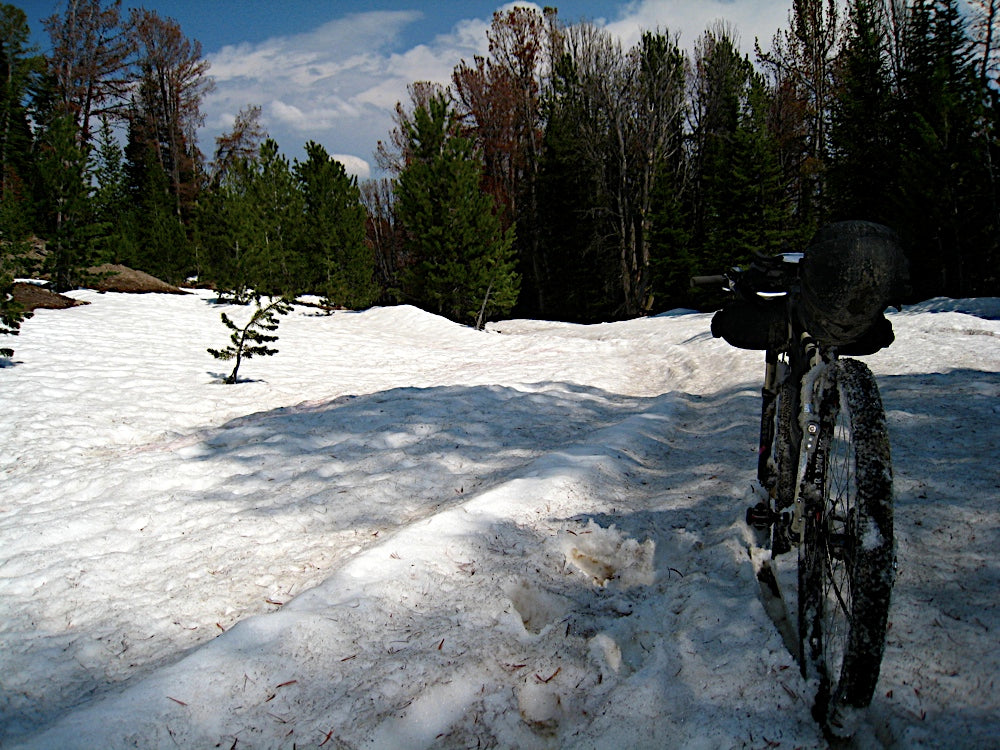 “It's kind of deceiving to look at the route by the numbers because it is only 5% singletrack and 95% road. But a road in Montana in June is covered with downed trees. You end up lifting your bike over piles of trees because they hadn't been cleared yet from winter. And your bike is fully loaded, so it weighs like 45 pounds because you've got your water and gear. It’s tough to heave it up over all these trees. Then there are a lot of dirt roads. Or you might end up walking through snow fields for hours. Even though there’s a road on the map, it's not a road ride."
“It's kind of deceiving to look at the route by the numbers because it is only 5% singletrack and 95% road. But a road in Montana in June is covered with downed trees. You end up lifting your bike over piles of trees because they hadn't been cleared yet from winter. And your bike is fully loaded, so it weighs like 45 pounds because you've got your water and gear. It’s tough to heave it up over all these trees. Then there are a lot of dirt roads. Or you might end up walking through snow fields for hours. Even though there’s a road on the map, it's not a road ride."
The Challenge of Finding Food and Water
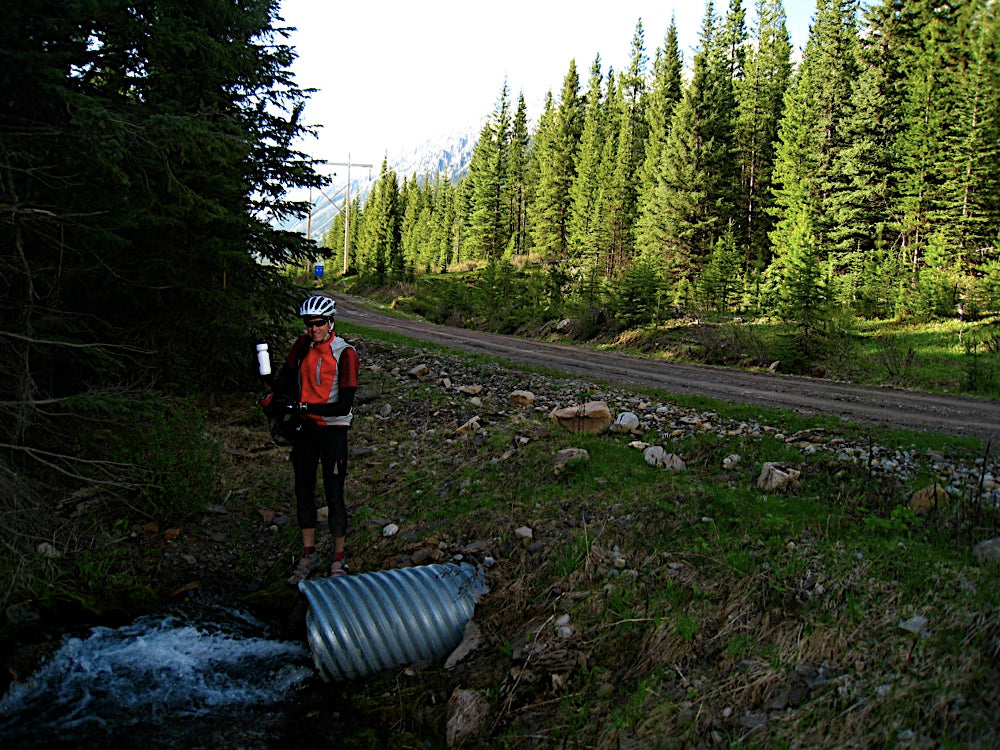 “Food and water were really challenging, especially when I did it. Not many people had done it before, and that year, there weren’t many riders further ahead of me who could share information with me. So you didn't really know where the water was.
“Food and water were really challenging, especially when I did it. Not many people had done it before, and that year, there weren’t many riders further ahead of me who could share information with me. So you didn't really know where the water was.
“The Adventure Cycling Association had maps then, and there would be information from people who had ridden along the route that would say, ‘In the Great Divide Basin near this road intersection, there's a spring where you can get water.’ But it was unreliable. Because the spring would be dried up or something. So water was really challenging."
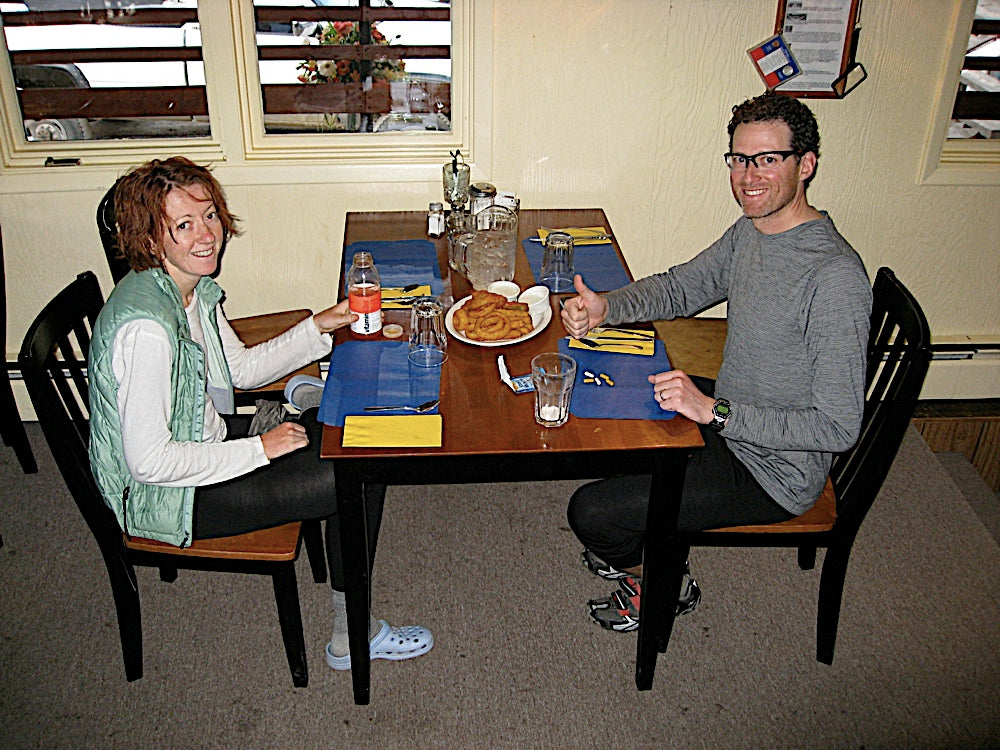 “It's a self-supported race. So no one can bring you food, but you can stop at gas stations and restaurants en route and fuel up. These gas stations weren't prepared for multiple riders to come through in a matter of days. They didn't have fresh fruits and vegetables or anything like that. It has since scaled up, but it was really hard to find decent nutrition or good food back then. I think it's still kind of hard to find good, healthy options. But you carried as much as you could depending on how far you needed to go that day and then stopped at gas stations along the way."
“It's a self-supported race. So no one can bring you food, but you can stop at gas stations and restaurants en route and fuel up. These gas stations weren't prepared for multiple riders to come through in a matter of days. They didn't have fresh fruits and vegetables or anything like that. It has since scaled up, but it was really hard to find decent nutrition or good food back then. I think it's still kind of hard to find good, healthy options. But you carried as much as you could depending on how far you needed to go that day and then stopped at gas stations along the way."
How Did You Sleep Out There?
 “It depends on how fast you want to go. So there are a couple of ways to go faster. One way is to carry very little and just plan to get to hotels. But that's really risky. And I would say not a lot of people do that. I only stayed at hotels a few times, and I was out there for 30 days. Hotels can be a good place to get quality sleep, but they can also make you so comfortable that you sleep for too long and you're not competitive anymore.
“It depends on how fast you want to go. So there are a couple of ways to go faster. One way is to carry very little and just plan to get to hotels. But that's really risky. And I would say not a lot of people do that. I only stayed at hotels a few times, and I was out there for 30 days. Hotels can be a good place to get quality sleep, but they can also make you so comfortable that you sleep for too long and you're not competitive anymore.
“For sleeping out in the open, I took a rain fly and a ground cloth. It was pretty minimal and lightweight. I just wanted to have something over me, especially since I'm a small woman and I didn't want to feel vulnerable out there. I wanted to have a little bit of camouflage and cover over me.”
How To Navigate Without GPS
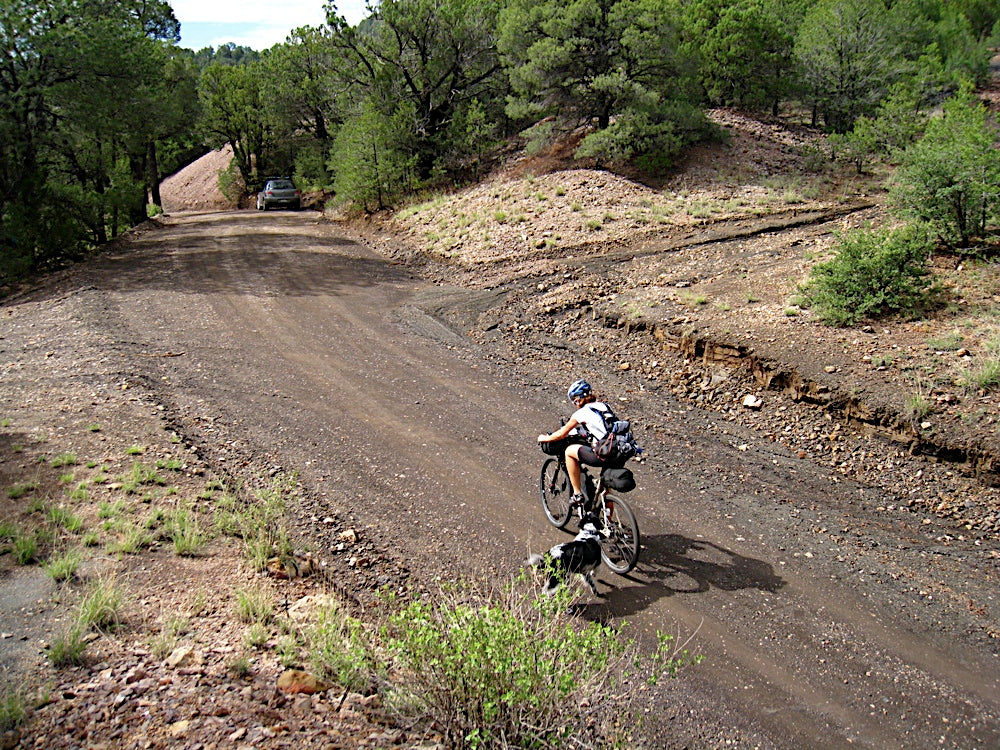 “It's going to sound like I raced 100 years ago, but it was only 15 years ago! There were some people that had GPS, but the problem back then was being able to charge it. I didn’t have a smartphone, I had a flip phone.
“It's going to sound like I raced 100 years ago, but it was only 15 years ago! There were some people that had GPS, but the problem back then was being able to charge it. I didn’t have a smartphone, I had a flip phone.
“I had a paper map. I had seven paper maps, actually. I carried half of the maps on me and shipped the other half to myself so I could pick them up halfway through the route. I had to stop and fold them out and read them."
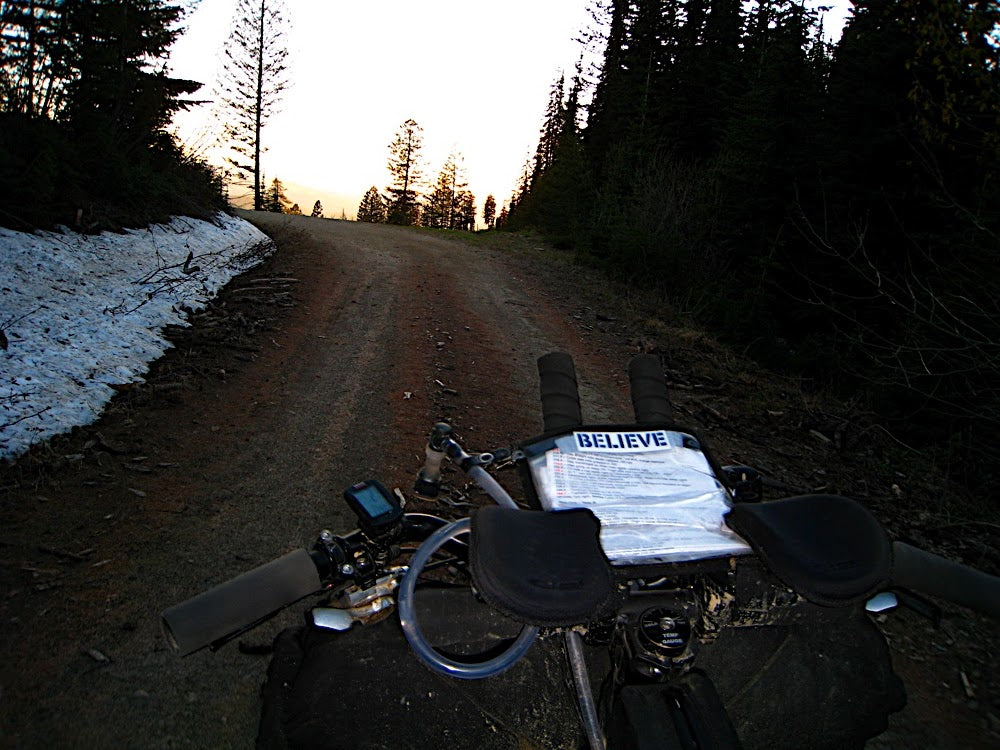 “Then also on my handlebars, I had cue sheets. In the Adventure Cycling Association maps, there are cues in there. Like, ‘There's a hostel at mile 283,’ or ‘There's a store with provisions at whatever mile.’ So I took those cues and any other information that I had from people who had ridden the route before and put that all onto these cue sheets.
“Then also on my handlebars, I had cue sheets. In the Adventure Cycling Association maps, there are cues in there. Like, ‘There's a hostel at mile 283,’ or ‘There's a store with provisions at whatever mile.’ So I took those cues and any other information that I had from people who had ridden the route before and put that all onto these cue sheets.
“I also carried a compass and an altimeter. When you’re riding along the divide, you’re going up and down an elevation so much. I would know I was at the place where I needed to turn because it would say on the queue sheets, ‘Your turn is at about 7500 ft elevation,’ or whatever. Those were my navigation tools.
“I only got lost a couple of times. The consequences for going off-route were big and you’d lose a lot of time. So I actually was really vigilant about navigation to not get too far off route.”
What Else Was Really Different About the First Tour Divide?
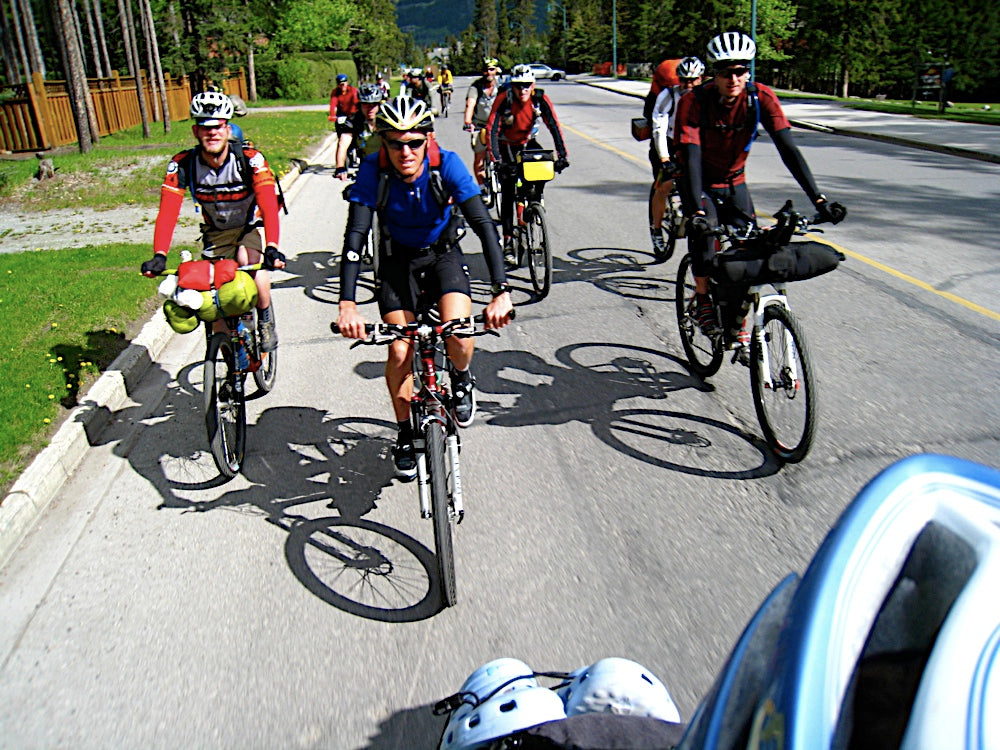 “The year I did the race, there were 17 of us that started the race. Now there are about 170 every year. There's a lot more visibility now. Ride the Divide definitely put a spotlight on the race.
“The year I did the race, there were 17 of us that started the race. Now there are about 170 every year. There's a lot more visibility now. Ride the Divide definitely put a spotlight on the race.
“Since then, there have been a lot of other riders documenting their own ride and sharing it, or other people making films. A lot more people understand what it's about. And there are fans out there now, cheering people on as they come through towns!"
 “It was also, I think, one of the very first races that used Spot trackers. We weren't even 100% sure it was going to work. Like I said, I had a flip phone. Some days I would turn it on to just check in with family, and make sure nothing was going crazy out there. I'd have all these voicemails because I didn't reset my Spot tracker the day before and nobody knew. Is the map broken? What's going on? Did she stop riding? They’d kind of freak out.
“It was also, I think, one of the very first races that used Spot trackers. We weren't even 100% sure it was going to work. Like I said, I had a flip phone. Some days I would turn it on to just check in with family, and make sure nothing was going crazy out there. I'd have all these voicemails because I didn't reset my Spot tracker the day before and nobody knew. Is the map broken? What's going on? Did she stop riding? They’d kind of freak out.
“I’d stop in a bike shop and check in on my blog, on BlogSpot. People would comment, and that was kind of the only way I could communicate with people, by putting up a blog post. That was it, really.”
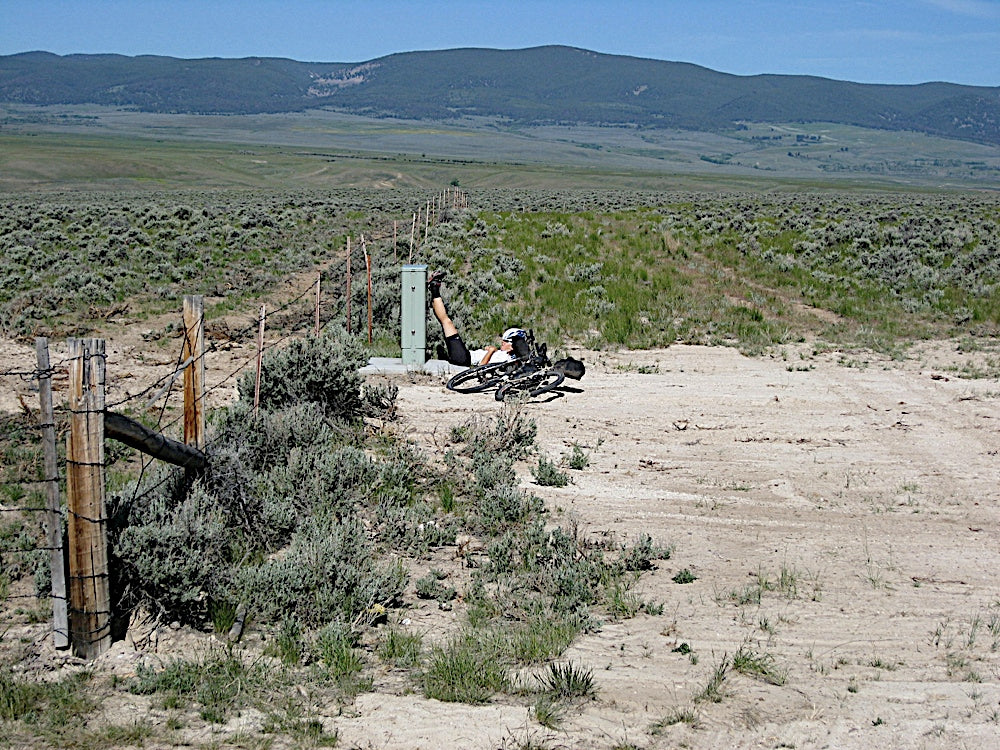 Put those legs up, Mary, you deserve it.
Put those legs up, Mary, you deserve it.
[button]Shop Bikes[/button]











